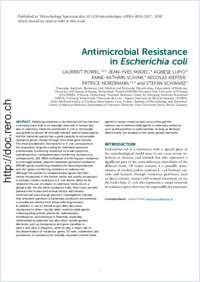Antimicrobial Resistance in Escherichia coli
- Poirel, Laurent Medical and Molecular Microbiology, Department of Medicine, University of Fribourg, Switzerland
- Madec, Jean-Yves Université de Lyon, Unité Antibiorésistance et Virulence Bactériennes, Lyon, France
- Lupo, Agnese Université de Lyon, Unité Antibiorésistance et Virulence Bactériennes, Lyon, France
- Schink, Anne-Kathrin Institute of Microbiology, Department of Veterinary Medicine, Freie Universität Berlin, Germany
- Kieffer, Nicolas Medical and Molecular Microbiology, Department of Medicine, University of Fribourg, Switzerland
- Nordmann, Patrice Medical and Molecular Microbiology, Department of Medicine, University of Fribourg, Switzerland
- Schwarz, Stefan French INSERM European Unit, University of Fribourg, Switzerland
-
12.07.2018
Published in:
- Microbiology Spectrum. - 2018, vol. 6, no. 4, p. ARBA-0026-2017
English
Multidrug resistance in Escherichia coli has become a worrying issue that is increasingly observed in human but also in veterinary medicine worldwide. E. coli is intrinsically susceptible to almost all clinically relevant antimicrobial agents, but this bacterial species has a great capacity to accumulate resistance genes, mostly through horizontal gene transfer. The most problematic mechanisms in E. coli correspond to the acquisition of genes coding for extended-spectrum β-lactamases (conferring resistance to broad-spectrum cephalosporins), carbapenemases (conferring resistance to carbapenems), 16S rRNA methylases (conferring pan-resistance to aminoglycosides), plasmid-mediated quinolone resistance (PMQR) genes (conferring resistance to [fluoro]quinolones), and mcr genes (conferring resistance to polymyxins). Although the spread of carbapenemase genes has been mainly recognized in the human sector but poorly recognized in animals, colistin resistance in E. coli seems rather to be related to the use of colistin in veterinary medicine on a global scale. For the other resistance traits, their cross-transfer between the human and animal sectors still remains controversial even though genomic investigations indicate that extended- spectrum β-lactamase producers encountered in animals are distinct from those affecting humans. In addition, E. coli of animal origin often also show resistances to other—mostly older—antimicrobial agents, including tetracyclines, phenicols, sulfonamides, trimethoprim, and fosfomycin. Plasmids, especially multiresistance plasmids, but also other mobile genetic elements, such as transposons and gene cassettes in class 1 and class 2 integrons, seem to play a major role in the dissemination of resistance genes. Of note, coselection and persistence of resistances to critically important antimicrobial agents in human medicine also occurs through the massive use of antimicrobial agents in veterinary medicine, such as tetracyclines or sulfonamides, as long as all those determinants are located on the same genetic elements.
- Faculty
- Faculté des sciences et de médecine
- Department
- Médecine 3ème année
- Language
-
- English
- Classification
- Biological sciences
- License
- License undefined
- Identifiers
-
- RERO DOC 324129
- DOI 10.1128/microbiolspec.ARBA-0026-2017
- Persistent URL
- https://folia.unifr.ch/unifr/documents/307580
Statistics
Document views: 76
File downloads:
- nor_are.pdf: 402
